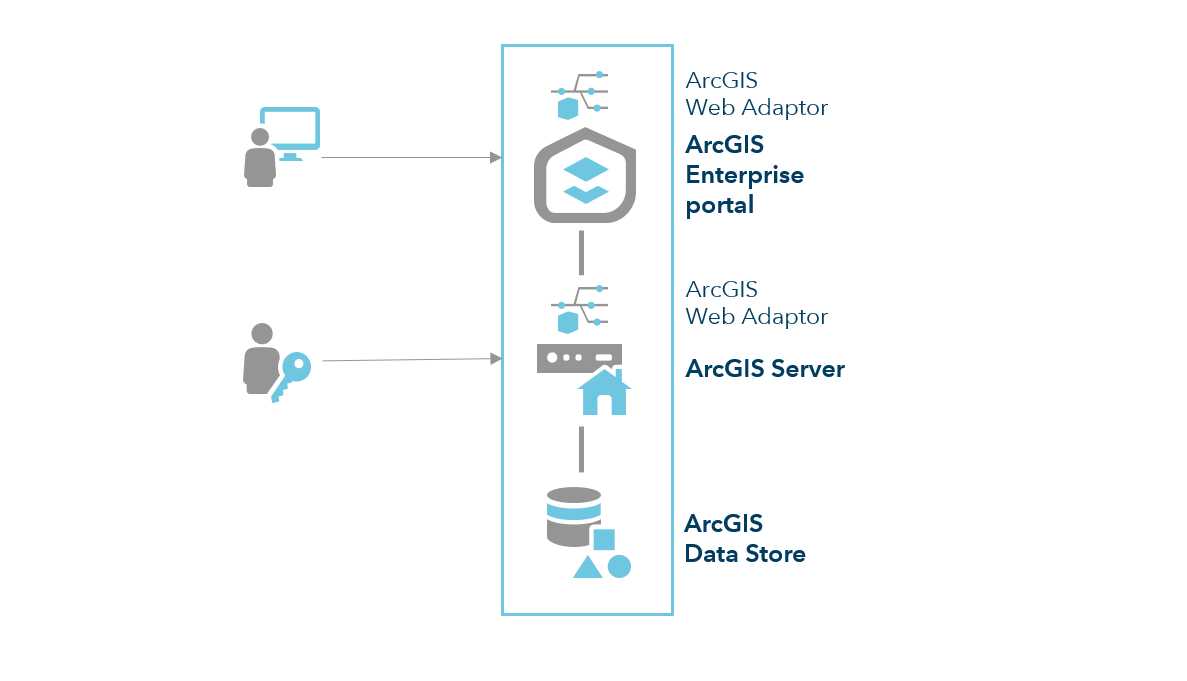ArcGIS Enterprise is the foundational software system for GIS, powering mapping and visualization, analytics, and data management. It is the backbone for running the Esri suite of applications and your own custom applications. ArcGIS Enterprise is tightly integrated with ArcGIS Pro for mapping and authoring, and seamlessly connects with ArcGIS Online to share content between systems.
Collaboration and flexibility are central to ArcGIS Enterprise, allowing you to organize and share your work on any device, anywhere, at any time.
ArcGIS Enterprise gives you complete control over your deployment. It can be run on Microsoft Windows, Linux, and Kubernetes, and it supports small single-machine deployments as well as large multimachine deployments in the following:
- Public cloud infrastructure that you manage
- Private cloud infrastructure
- On-premises infrastructure using physical or virtualized hardware
This flexibility unlocks advanced capabilities to support your organization's needs, such as tracking real-time data, performing big data analysis, raster analytics, hosting image services, and data science workflows. Your ArcGIS Enterprise deployment can also be connected or disconnected from the open internet, and can be configured to prevent data loss and downtime in the event of disaster.

Software components
The four components of ArcGIS Enterprise work together to provide comprehensive functionality for web mapping, image exploitation, real-time data handling, large-volume batch analysis, and spatial data science:
- ArcGIS Server powers mapping and analysis in your GIS, including several specialized server roles, and scales dynamically to support traffic.
- The ArcGIS Enterprise portal is the central hub where users create, share, and manage maps, apps, and spatial data and share them with collaborators.
- ArcGIS Data Store provides data storage for the hosting server used with your deployment.
- ArcGIS Web Adaptor integrates ArcGIS Server and Portal for ArcGIS with your existing web servers and your organization's security infrastructure.
A base ArcGIS Enterprise deployment is the minimum setup, combining all four ArcGIS Enterprise components. See Base ArcGIS Enterprise deployment for details.
After the base deployment is installed, you can begin using ArcGIS Enterprise, or configure additional capabilities.
ArcGIS Enterprise licensing
ArcGIS Enterprise is licensed per user and by system capacity. Users are licensed based on user types, providing secure access to information and content creation capabilities. See User types, roles, and privileges for detailed information on user types and capabilities.
ArcGIS Server roles
ArcGIS Server can be licensed in a variety of roles, depending on the capabilities you want to enable for your deployment. Server licensing roles define the capabilities of each ArcGIS Enterprise server machine or site. For a full description of options, see the ArcGIS Enterprise functionality matrix.
ArcGIS GIS Server brings GIS resources such as map services, feature services, and geoprocessing services to users as layers in your organization. This role is the foundation for your Web GIS, where the GIS Server acts as the portal's hosting server. You can license ArcGIS GIS Server as Advanced, Standard, or Basic. All editions of ArcGIS Enterprise include an ArcGIS Server licensed in a GIS Server role. ArcGIS GIS Server also offers additional extensions. See ArcGIS GIS Server capabilities and extensions for details.
Note:
The Basic edition of ArcGIS Server can only enable enterprise geodatabases and cannot be used as a hosting server for a Web GIS.Add more capabilities to the base ArcGIS Enterprise deployment by licensing additional server roles:
- ArcGIS GeoAnalytics Server performs distributed analytics on large volumes of tabular and feature data.
- ArcGIS GeoEvent Server integrates real-time, event-based data streams, as from Internet of Things sources, into your GIS.
- ArcGIS Image Server publishes image services for real-time visualization and performs distributed analytics on raster data.
- ArcGIS Knowledge Server enables an entity-centric approach to data modeling and analysis using knowledge graphs.
- ArcGIS Notebook Server hosts ArcGIS Notebooks, which combine code, real-time visualizations and maps, and data tools to facilitate data science.
- ArcGIS Workflow Manager is a scalable workflow management system that automates and simplifies many aspects of performing and managing GIS and non-GIS work in an organization to increase productivity. ArcGIS Workflow Manager is licensed through the ArcGIS Workflow Manager user type extension.
To apply these ArcGIS Server roles, install the ArcGIS Server component and use the appropriate license file to enable the role. Multiple server license roles can be applied to the same machine or site as the base ArcGIS Enterprise deployment, or they can be deployed independently of the base deployment. To ensure enough machine resources will be available to support server operations, review the system requirements for each server licensing role. It is generally recommended that you deploy separate ArcGIS Server sites for each role. See ArcGIS Server licensing roles for more information.